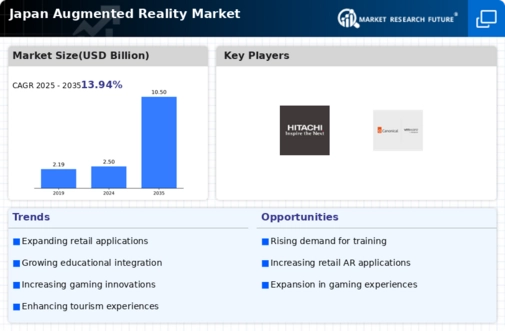Rising Demand in Healthcare
The healthcare sector in Japan is increasingly adopting augmented reality technologies, which is significantly impacting the augmented reality market. AR applications are being utilized for surgical training, patient education, and even remote consultations. By 2025, the healthcare segment is expected to account for nearly 30% of the total augmented reality market share in Japan. This trend is driven by the need for improved patient outcomes and the desire for more interactive and engaging medical training methods. Furthermore, the integration of AR in medical devices is enhancing the precision of surgical procedures, thereby reducing risks and improving recovery times. As healthcare professionals recognize the benefits of AR, the market is likely to see continued growth, with investments in AR solutions becoming a priority for hospitals and medical institutions.
Increased Investment in AR Startups
The augmented reality market in Japan is witnessing a notable increase in investment directed towards AR startups. Venture capital firms and corporate investors are recognizing the potential of AR technologies across various sectors, including retail, education, and entertainment. In 2025, investments in AR startups are projected to exceed $500 million, indicating a robust interest in innovative applications of augmented reality. This influx of capital is fostering a vibrant ecosystem where new ideas can flourish, leading to the development of cutting-edge AR solutions. As these startups introduce novel applications and services, the augmented reality market is likely to expand, creating new opportunities for collaboration and growth within the industry. The competitive landscape is evolving, with established companies also seeking partnerships with startups to enhance their AR offerings.
Technological Advancements in Hardware
The augmented reality market in Japan is experiencing a surge due to rapid advancements in hardware technology. Devices such as AR glasses and headsets are becoming more sophisticated, offering enhanced user experiences. For instance, the introduction of lightweight and high-resolution displays has made AR devices more appealing to consumers. In 2025, the market for AR hardware in Japan is projected to reach approximately $1.5 billion, reflecting a growth rate of around 25% annually. This growth is driven by increased investment in research and development by local tech companies, which are striving to create innovative solutions that cater to various industries. As hardware becomes more accessible and affordable, the augmented reality market is likely to expand further, attracting a broader audience and fostering new applications across different sectors.
Growing Interest in Remote Collaboration Tools
The augmented reality market in Japan is benefiting from a growing interest in remote collaboration tools, particularly in the wake of increased digital transformation across industries. Companies are increasingly adopting AR solutions to facilitate virtual meetings, training sessions, and collaborative projects. By 2025, the market for AR collaboration tools is expected to grow by approximately 40%, driven by the need for effective communication in a hybrid work environment. This trend is particularly relevant in sectors such as manufacturing and engineering, where AR can provide real-time visualizations and remote assistance. As organizations recognize the advantages of AR in enhancing productivity and reducing travel costs, the demand for these tools is likely to rise, further propelling the augmented reality market forward.
Expansion of AR in Tourism and Cultural Heritage
The augmented reality market in Japan is experiencing growth through its application in tourism and cultural heritage. AR technologies are being utilized to enhance visitor experiences at historical sites and museums, providing interactive and immersive storytelling. By 2025, the tourism sector is anticipated to contribute significantly to the augmented reality market, with projections indicating a market size of around $300 million. This growth is fueled by the increasing number of domestic and international tourists seeking unique experiences. AR applications allow visitors to engage with cultural artifacts in innovative ways, thereby enriching their understanding and appreciation of Japan's rich heritage. As tourism continues to evolve, the integration of AR is likely to become a standard practice, further solidifying its role in the augmented reality market.













Leave a Comment